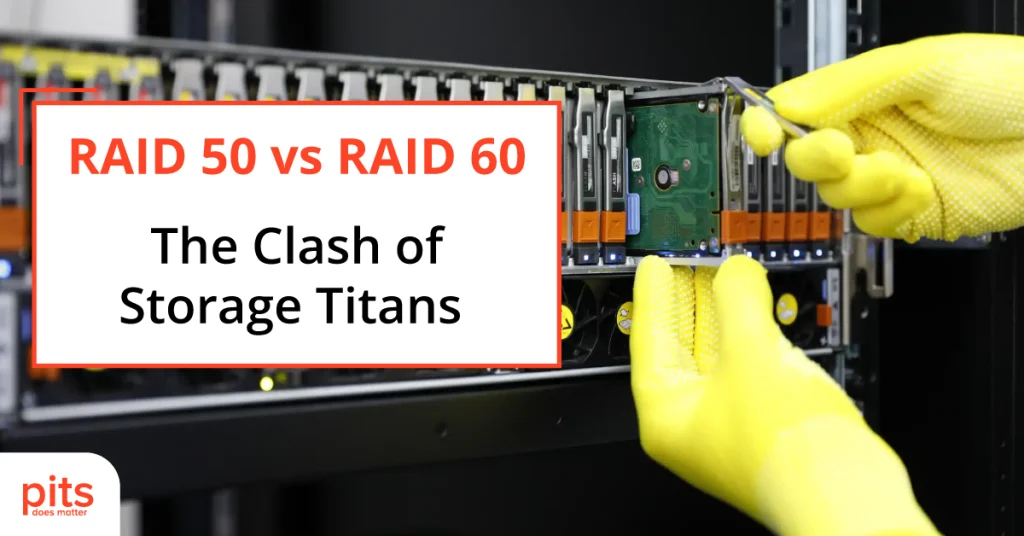In the world of data storage and protection, RAID configurations are a vital element, ensuring data integrity and availability. When tasked with selecting the ideal RAID level for your organisation, you’re often presented with various options, each with its unique strengths and weaknesses.
Among these choices, RAID 50 and RAID 60 are two frequently implemented configurations. In this comprehensive guide, we will delve into the nuances, advantages, and drawbacks of RAID 50 and RAID 60 to empower you with the knowledge to make an informed decision.
What are RAID 50 and RAID 60?
Before delving into an in-depth comparison, let’s establish a clear understanding of RAID 50 and RAID 60, grounding ourselves in the fundamentals of these two RAID configurations.
RAID 50
RAID 50, often referred to as “striping with distributed parity,” is essentially a combination of two RAID levels: RAID 5 and RAID 0. Its core purpose is to strike a balance between data redundancy and performance.
Within a RAID 50 array, data is striped across multiple RAID 5 arrays. Each RAID 5 array consists of multiple drives, and the data is distributed across these arrays. Moreover, RAID 50 incorporates parity data, which is meticulously distributed across the drives to provide redundancy and fault tolerance.
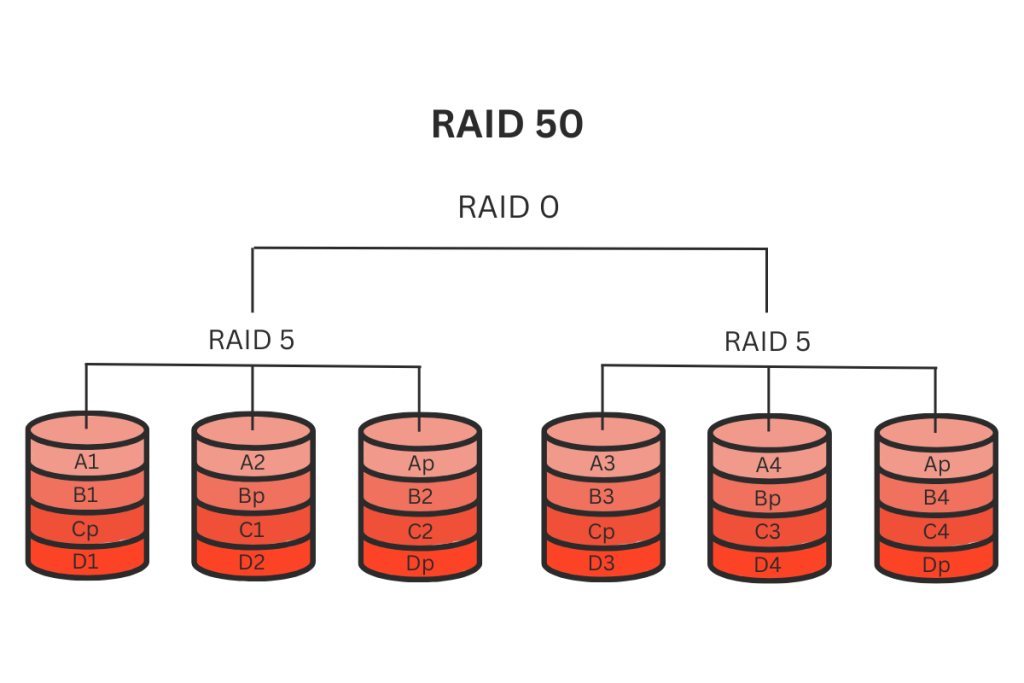
Advantages of RAID 50
- Performance: RAID 50 stands out for its exceptional read and write performance compared to RAID 5. This performance boost is primarily attributable to the data striping across multiple RAID 5 arrays.
- Redundancy: Despite its performance prowess, RAID 50 does not compromise on redundancy. It ensures data security through distributed parity, meaning that if a single drive fails within one of the RAID 5 arrays, data can still be reconstructed using the parity information.
- Capacity: RAID 50 can accommodate larger storage configurations since it amalgamates multiple RAID 5 arrays.
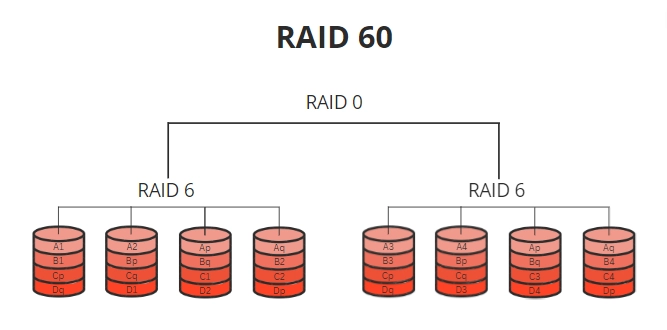
RAID 60
In contrast, RAID 60 is an extension of RAID 6 and RAID 0, engineered to provide enhanced fault tolerance and performance while maintaining a fine balance between redundancy and capacity.
Within a RAID 60 array, data is striped across multiple RAID 6 arrays. Each of these RAID 6 arrays includes two parity blocks, providing dual redundancy. Similar to RAID 50, RAID 60 employs striping to enhance performance.
Advantages of RAID 60
- Redundancy: The standout feature of RAID 60 is its remarkable fault tolerance. It achieves this through the inclusion of dual parity blocks within each RAID 6 array. Consequently, RAID 60 can endure the failure of up to two drives within a single RAID 6 array without incurring data loss, a feat that RAID 50 cannot match.
- Performance: While not as fast as RAID 50, RAID 60 offers commendable performance, particularly for read-intensive tasks.
- Data Integrity: RAID 60 is designed to maintain data integrity even in the face of multiple drive failures, making it eminently suitable for critical applications.
Comparing RAID 50 vs RAID 60
Now that we have gained a foundational understanding of RAID 50 and RAID 60, let us embark on a comprehensive comparison, evaluating them across various critical aspects to facilitate your selection process.
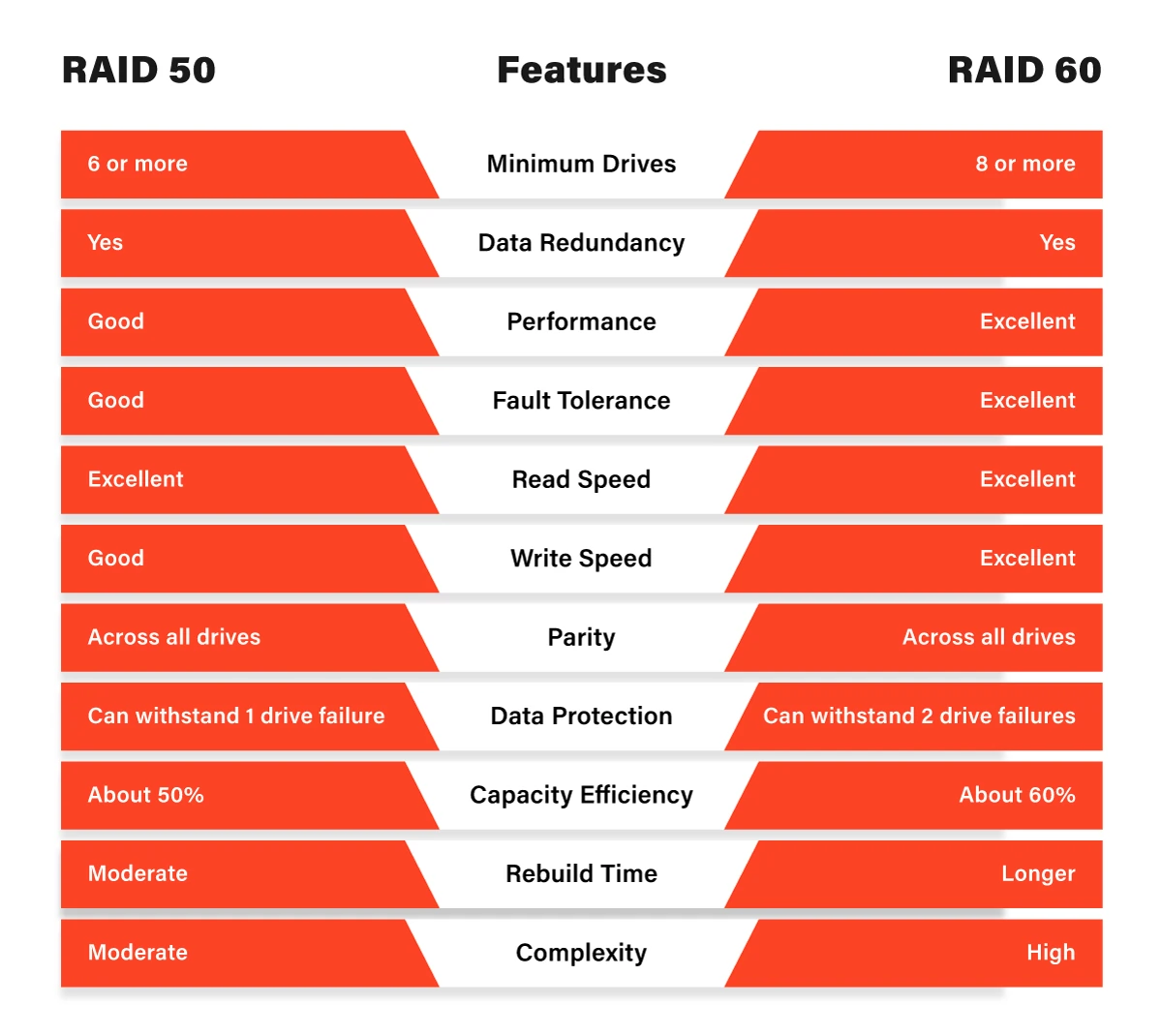
Fault Tolerance
Both RAID 50 and RAID 60 integrate parity data to deliver fault tolerance. However, RAID 60 takes the lead in this department, offering superior fault tolerance because of its dual parity blocks within each RAID 6 array. This means RAID 60 can withstand the failure of up to two drives in a single RAID 6 array without data loss, while RAID 50 can only tolerate the failure of a single drive within a RAID 5 array.
Performance
Regarding performance, RAID 50 generally outpaces RAID 60 across most workloads. The secret to RAID 50’s success lies in the striping of data across multiple RAID 5 arrays. That being said, RAID 60 isn’t far behind and offers commendable performance, particularly for tasks demanding intensive data reads.
Capacity
RAID 50 has the upper hand in terms of storage capacity. As it amalgamates multiple RAID 5 arrays, it can offer a more extensive overall storage capacity compared to RAID 60. If maximising storage space is your chief objective, RAID 50 may emerge as the more suitable option.
Data Rebuild Time
In the unfortunate event of drive failure, RAID 50 and RAID 60 necessitate a rebuild process to reinstate data redundancy. Typically, RAID 50 enjoys a shorter rebuild time, primarily because of its involvement with smaller RAID 5 arrays. On the other hand, RAID 60’s rebuild time can be more protracted, owing to the larger RAID 6 arrays and the necessity to compute dual parity blocks.
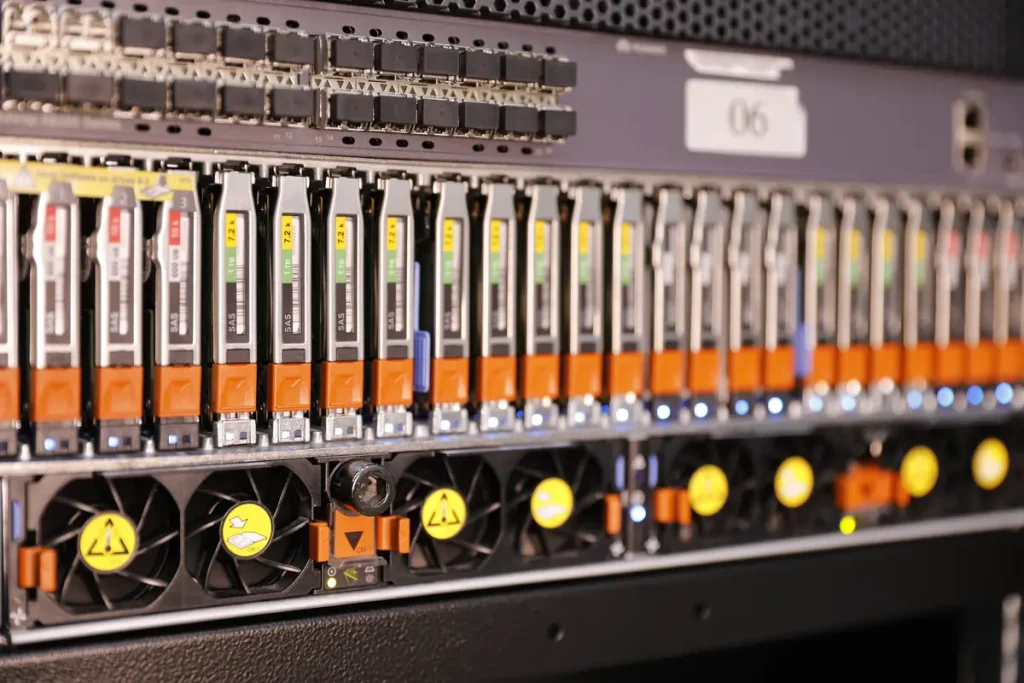
Use Cases
- RAID 50: This configuration is exceptionally well-suited for environments requiring a harmonious blend of performance and redundancy. It finds common usage in file servers, database servers, and virtualisation environments.
- RAID 60: RAID 60 shines in environments where data integrity and elevated fault tolerance are imperative. It’s an ideal choice for large-scale enterprise storage systems, online transaction processing (OLTP) databases, and archival systems.
Choosing the Right RAID Level for Your Needs: RAID 60 vs RAID 50
Ultimately, the selection between RAID 50 and RAID 60 hinges on your specific requirements and priorities. To aid you in your decision-making process, here are some key considerations:
- Data Criticality: If your data is of paramount importance and any form of downtime or data loss is unacceptable, RAID 60, with its heightened fault tolerance, stands as the safer choice.
- Performance vs Redundancy: If performance takes precedence over redundancy, provided you have robust backup solutions in place, RAID 50 may emerge as the more suitable option.
- Budget: RAID 50 tends to be more cost-effective, as it necessitates fewer drives for the same storage capacity in comparison to RAID 60.
- Scalability: It is essential to contemplate your future scalability requirements. RAID 50 offers a more flexible scalability path because of its reliance on smaller arrays, whereas RAID 60 may demand the addition of more drives at once because of its employment of larger arrays.
Data Recovery Considerations for RAID 60 vs RAID 50
At PITS, we recognise that despite the implementation of robust RAID configurations and meticulous precautions, data loss can still transpire because of a myriad of factors, including hardware malfunctions, human errors, or software glitches. In the realms of both RAID 50 and RAID 60, data recovery can be intricate.
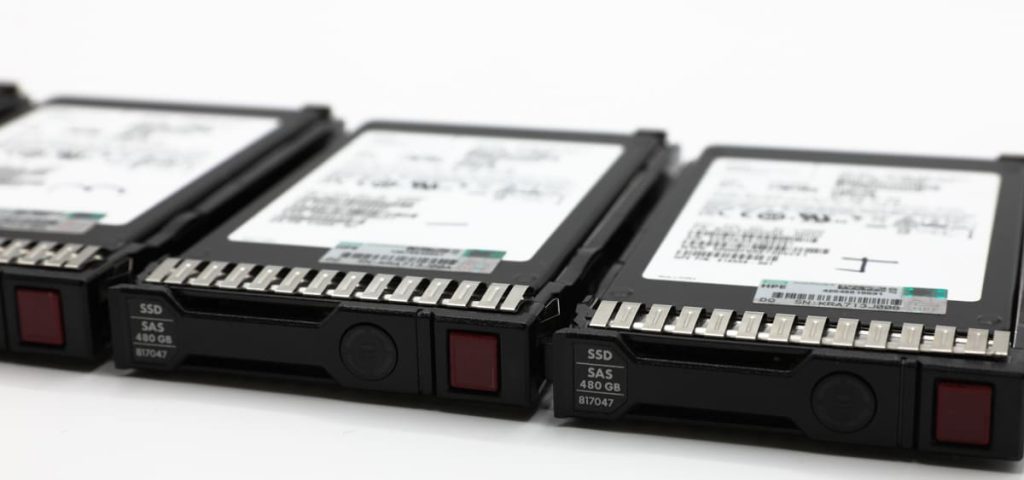
- RAID 50 Recovery: Data recovery from a RAID 50 array can be challenging, especially when multiple drives fail simultaneously. Our team of experts specialises in RAID data recovery and possesses the expertise required to recover your data even in the face of such adversities.
- RAID 60 Recovery: While RAID 60 offers superior data redundancy, the process of data recovery can still be intricate in cases of multiple drive failures. Our advanced data recovery methodologies, complemented by state-of-the-art equipment, bolster the probability of a successful data recovery operation.
In the ongoing deliberation of RAID 50 versus RAID 60, there exists no universally applicable solution. Your choice should be an outgrowth of your unique data storage and protection prerequisites. RAID 50 strikes a balance between performance and redundancy, while RAID 60 excels in fault tolerance and data integrity.
At PITS Global Data Recovery Services, we stand ready to assist you in the deployment of the ideal RAID configuration for your organisation and, should the need arise, provide expert data recovery services to safeguard your invaluable data. Regardless of whether you opt for RAID 50 or RAID 60, always bear in mind that regular backups and proactive monitoring constitute essential components of a comprehensive data protection strategy.
Frequently Asked Questions
What is RAID 50 and RAID 60?
RAID 50 is a combination of RAID 5 and RAID 0, offering a balance between performance and redundancy. RAID 60, on the other hand, extends RAID 6 with striping for enhanced fault tolerance and performance.
When should I choose RAID 50?
RAID 50 is suitable when you need a balance between performance and redundancy. It’s commonly used in environments like file servers, database servers, and virtualisation setups.
When should I consider RAID 60?
RAID 60 is an excellent choice when data integrity and high fault tolerance are paramount. It’s often used in large-scale enterprise storage systems, OLTP databases, and archival systems.
What should I prioritise: performance or redundancy?
Your choice should align with your specific needs. If data performance is critical and you have robust backup solutions, RAID 50 might be preferable. For data-critical environments, RAID 60’s superior fault tolerance is a better fit.
